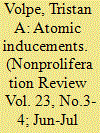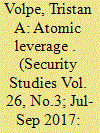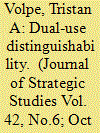| Srl | Item |
| 1 |
ID:
152070


|
|
|
|
|
| Summary/Abstract |
This article argues for an updated strategy to limit the spread of sensitive nuclear technology around the globe. Traditional efforts by the United States to deny countries access to enrichment and reprocessing (ENR) technology are becoming difficult to enforce, while the threat of sanctions against US allies with legal nuclear-energy programs is not credible. As a result, the United States should shift toward a strategy of “buying out” an ally’s ambition for sensitive nuclear technology. Offering military, political, and economic assistance in exchange for stringent nonproliferation commitments will only work when offered at the earliest stage of technical development, before the country builds capabilities that will be difficult or expensive to give up. While there are some practical challenges to implementing such a strategy, the conditions are right to see if lucrative nuclear-energy offers—notably spent-waste management solutions—can induce countries with new civil nuclear programs to foreclose the option to develop ENR technology in the future.
|
|
|
|
|
|
|
|
|
|
|
|
|
|
|
|
| 2 |
ID:
153181


|
|
|
|
|
| Summary/Abstract |
Nuclear proliferation is not a binary outcome with uniform consequences, but instead spans a continuum of latent capacity to produce nuclear weapons. At various thresholds of technical development, some countries leverage nuclear latency to practice coercive diplomacy. How and when does nuclear technology provide a challenger with the most effective means to extract concessions in world politics? This article claims that compellence with nuclear latency puts a challenger on the horns of a credibility dilemma between demonstrating resolve and signaling restraint, and identifies a sweet spot for reaching an optimal bargain where the proliferation threat is credible while the assurance costs of revealing intent are low. Historical studies of South Korea, Japan, and North Korea validate this Goldilocks principle and find that it consistently reflects the ability to produce fissile material. Contrary to conventional wisdom about proliferation, nuclear technology generates political effects long before a country acquires nuclear weapons.
|
|
|
|
|
|
|
|
|
|
|
|
|
|
|
|
| 3 |
ID:
167676


|
|
|
|
|
| Summary/Abstract |
Additive manufacturing is being adopted by nuclear programmes to improve production capabilities, yet its impact on strategic stability remains unclear. This article uses the security dilemma to assess incentives for arms racing as the emerging technology becomes integrated into nuclear supply chains. Innovations sow the ground for competition by making it easier to produce weapons and harder to distinguish civil from military motives. But additive manufacturing could still mature into an asset by revealing greater information about nuclear aspirants. Beyond the nuclear realm, the article refines offense-defence theory to explain how changes in non-military technology shape the practice of deception.
|
|
|
|
|
|
|
|
|
|
|
|
|
|
|
|